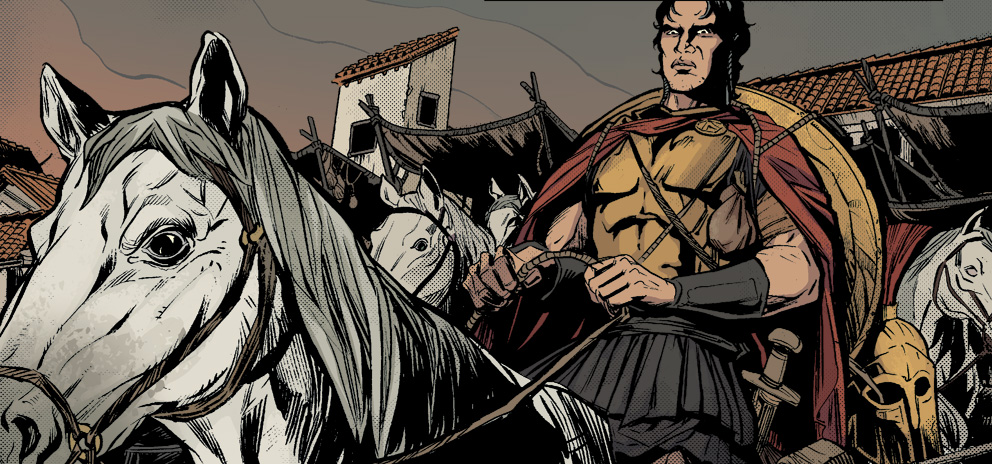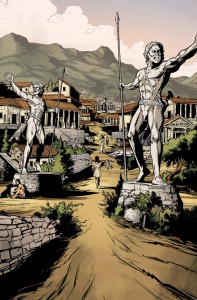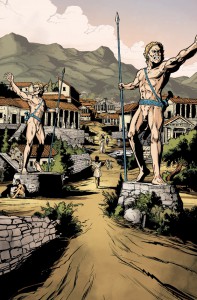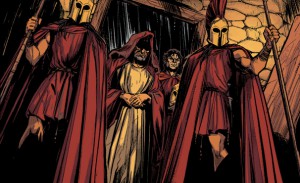
April 25, 2014, by Tara de Cozar
Comics and classics part three — statues and helmets
Comics writer Kieron Gillen spoke at the Classical Association annual conference, held at the University at the end of April. Prof Stephen Hodkinson was the historical consultant on his recent comics series Three. I’m writing a series of posts on their roundtable discussion ‘Story telling and historical authenticity in a visual medium: the comics series Three’. The original post is here. Part two is here.
When research isn’t conclusive
The panel gave an example of an issue which arose later in the process — the colouring — where the research couldn’t tell the team which way to go with any certainty. Were statues in Sparta white or painted? Colourist Jordie Bellaire did two different versions. The final decision was to go with painted.
Kieron: “We went with painting the statues because it was part of the endeavour and oh well, bloody hell just do it. Jordie’s big problem of course was the fact that there was no good reference for them, and that’s maddening for a colourist. Especially because this is academia, it’s a moving target. Something could come out next week that makes Jordie look like an idiot forever. We had the logic that it was worth trying. Even if its not right forever, it’s worth trying to do as best we can with what we have. That said, we did have several reviews which were bewildered by the painted statues saying it took them out of the book.”
Lynn: “The example this reminded me of is when they were building the set on the 1963 film Cleopatra, and they built an accurate Roman forum. The director came along and said: ‘It’s not big enough’. Because he as a director new that the audience he ws aiming at had an image on ancient Rome and you have to take that into account. You can’t present something that looks too different to what people are expecting. It’s not what they expect, so they go against it — without any knowledge of the original sources.”
There was also discussion around the use of the ‘classic’ Corinthian helmet. The first scene introducing key Spartan characters features them. And they’re used later in the comics as signifiers of separation.
Kieron: “We see two Spartan warriors, who are disposable — which is why we can’t see their faces. We want to distance them. It’s here that we hit the problem of the Corinthian helmet. It’s not really seen in this period very much. So we went back and forth a lot about it. As an icon it’s very useful. As a piece of history, it wasn’t.”
Stephen: “The fact is, by the fourth century BC when this story is set, very few were wearing Corinthian helmets. But there’s something iconic about the Corinthian helmet. So for the first appearance of the Spartans, and for the two anonymous characters who are shortly to get murdered, it’s suitable. But further on, you’ll see most of the Spartans wearing pilos helmets — a type of ‘beanie hat’ helmet made of metal or felt. Also, later in the story, Nestos take the old family armour from his home to wear in a personal quest — this includes the dated Corinthian helmet. That helps to visually distinguish him from the rest of the Spartans.”
Kieron: “The difference in armour gives a sense of the Spartans they used to be versus the Spartans they are now. The armour was a visual indicator. In the first issue in particular there was this idea that the helmets were very ‘othering’. We’re very much with the Helots so you get this sinister view of the Spartans. As we go into the story we get more of an idea of why the Spartans are as paranoid as they are. And then the helmets come off. By the end, the Helot puts on the helmet, and this distances him from the Spartans. The Spartans see him very much as an avenging spirit. That’s one of the great things about comics as a visual medium.
“Plus, there’s a lot here that people who don’t know the period at all won’t ever get. That allows us to sleep at night.”
Here’s that page where Nestos takes the family armour. It is beautiful, you can see why he did it…
No comments yet, fill out a comment to be the first





Leave a Reply